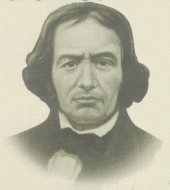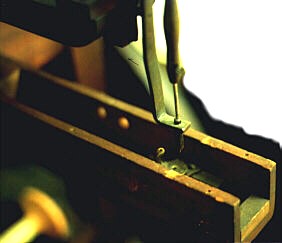Barthélemy Thimonnier facts for kids
Quick facts for kids
Barthélemy Thimonnier
|
|
|---|---|
 |
|
| Born | 19 August 1793 L'Arbresle, Rhône
|
| Died | 5 July 1857 (aged 63) Amplepuis
|
Barthélemy Thimonnier was a French inventor. He was born on August 19, 1793, in L'Arbresle, France. He died on July 5, 1857, in Amplepuis. Many people believe he invented the first sewing machine that could sew like a human hand.
Contents
Early Life of an Inventor
Barthélemy Thimonnier's family moved to Amplepuis in 1795. He was the oldest of seven children. He studied in Lyon for a bit. Later, he started working as a tailor in Panissières.
In January 1822, Barthélemy married an embroideress. By 1823, he had settled in a part of Saint-Étienne. There, he continued his work as a tailor.
Inventing the Sewing Machine
Even though the first sewing machine needle was patented in 1755, Thimonnier came up with his own sewing machine in 1829. In 1830, he teamed up with Auguste Ferrand, an engineer. Ferrand helped draw the plans and apply for a patent.
Their patent for the machine was officially given to them on July 17, 1830. The French government supported their invention. An important early supporter of Thimonnier was Mr. Beaunier from The Saint-Étienne miners' school.
It's interesting to know that an even earlier sewing machine was patented by Thomas Saint in 1790. However, Saint's invention wasn't widely known until 1874. That's when another sewing machine maker found his old drawings. So, Thimonnier's machine was very important, even if it wasn't the very first one ever made.
The Sewing Machine Incident
The same year his patent was granted, Thimonnier and his partners opened the world's first company to make clothes using machines. Their goal was to make uniforms for the army. They set up a workshop with about 80 sewing machines.
However, in 1831, a group of tailors became upset. They were worried about losing their jobs or having their wages cut because of the new machines. About 150 to 200 tailors went to the factory. They damaged many of the machines.
Newspapers at the time reported on the event. One newspaper, Moniteur, described how a group of tailors tried to break the machines. The police and National Guard had to step in. Many workers were taken to the police station.
Another newspaper, Gazette des Tribunaux, also wrote about the incident. They said that the National Guard stopped the machines from being completely destroyed. They also argued that new inventions like these were good for industry and workers in the long run.
Later, some of the workers involved were sentenced to short periods in prison.
Soon after this event, Thimonnier left the company. The whole company eventually closed down a few years later. This happened after Mr. Beaunier, a main investor, passed away.
A model of Thimonnier's machine is displayed at the London Science Museum. This machine was made of wood. It used a special needle that went down through the fabric. It would grab the thread and pull it up to form a loop. This loop would then be secured by the next stitch.
Later Life and Legacy
After leaving the company, Thimonnier went back to Amplepuis. He continued to work as a tailor. He also kept trying to make his sewing machine even better. He received new patents for improved models in 1841, 1845, and 1847.
Even though his machines won awards at World Fairs and were praised by newspapers, they didn't become widely used. Thimonnier faced financial difficulties throughout his life. He died in poverty at the age of 63.
However, his legacy lived on. A sewing machine company named Thimonnier was created after his death. It continued to exist well into the 20th century.
Images for kids
See also
 In Spanish: Barthélemy Thimonnier para niños
In Spanish: Barthélemy Thimonnier para niños



